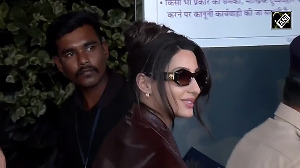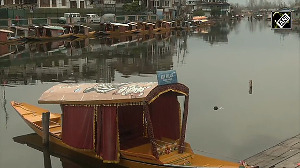Newspaper hawkers in Delhi could not believe their luck recently when cameramen and reporters from two major news channels Aaj Tak and Headlines Today trained their lights and microphones at them.
The occasion was the launch of Mail Today, a compact daily from the India Today group that owns the news magazine India Today and channels such as Aaj Tak, Dilli Aaj Tak and Headlines Today.
The India Today group CEO, Ashish Bagga, claims that the TV interviews were meant to record the launch of Mail Today, the media group's foray into the newspaper business in collaboration with Daily Mail of London.
However, the fact is that the TV cameras came handy in checking its rivals' attempts to block the new daily from being pushed by the hawkers.
For Daily Mail, however, establishing a foolproof distribution in the face of potent entry barriers that competition is said to be creating, is only part of the problem.
The newspaper will also have to contend with reader loyalty towards entrenched players like The Times of India from the Bennett, Coleman & Co Ltd and Hindustan Times from HT Media Ltd which sell 1.2 billion plus copies a day in the city and the National Capital Region.
However, Mail Today is not attempting to replace the existing newspapers, says Bagga. "It is a newspaper for the evolved reader. The basic premise is that television and the Internet break news today. So we have an eclectic mix of news and features. Besides, we are targeting the top of the pyramid the affluent reader (aged between 25 and 35) in the socio-economic category A," he adds.
Unimpressed, executives at rival newspaper groups say that Mail Today's product positioning is unclear. "It's difficult to say whether it's a tabloid or a serious newspaper," says Sameer Kapoor, president, Metropolitan Media, the ToI-HT JV company that publishes Metro Now.
Bagga argues: "It's a serious newspaper but we are in your face. Most publishers do not understand that positioning in India yet."
Bennett Coleman's Chief Executive Officer (publishing) Ravi Dhariwal, however, maintains that finer newspaper segmentation in India is a while away. "Today, newspapers are segmented only in terms of brand appeal."
Yet armed with a marketing budget of Rs 30 crore (Rs 300 million) in the first year, Mail Today is striving for the number one slot. It has launched a direct mail programme that offers the newspaper free for four months to 75,000 active India Today Group readers.
Business rivals sneer at the free paper offer but Bagga reasons: "The idea was to get into households, push sampling and create consumer pull. At Rs 2 to Rs 2.50 per copy, aren't the others also giving the newspaper virtually free?"
Partly true since newspaper prices hardly cover up the cost of production. For English dailies, 85-90 per cent of their revenue comes from advertising.
From its magazine experience the company knows that 50 per cent of the Mail Today subscribers will drop out once the free paper offer expires. Little surprise then, that the company has hired 350 salesmen to start enrolling paid subscribers to maintain the same level of readers after four months.
"We hope to sign up 35,000 subscribers in four months," says Bagga. To iron out the distribution glitches, it is tempting the trade with a 40 per cent commission and a medical insurance scheme.
It's not difficult to see why Mail Today, which hopes to launch 20 editions, began with Delhi. It is India's largest English print media advertising market today at Rs 1,300 crore (Rs 13 billion), growing at 22 per cent a year.
"The advertising potential is huge since the city is expanding to bring Ghaziabad, Noida, Faridabad and Gurgaon into its fold. The BPO, manufacturing and services industries are booming," observes Gopinath Menon, vice-president, TBWA India.
The paper may be "well funded" for its Delhi operations with Rs 51 crore (Rs 510 million) investment by the India Today Group and another Rs 20 crore (Rs 200 million) from the Associated Newspaper Group that owns the Daily Mail, but will it succeed?
"The biggest challenge will be fighting for the consumer's share of time who is cash rich and time poor," says Menon. The Indian Readership Survey figures back his point: The average time spent on print has shrunk from 31 minutes in 2003 to 29 minutes in 2006.
Besides, rivals will leave no stone unturned to keep fresh competition at bay. On the day of Mail Today's launch, Metro Now launched a scheme offering the paper at Rs 10 a month for three months. Delhi Mirror (a la Mumbai Mirror) is also on the cards as a freebie with The Times of India.
On the upside, Mail Today has probably been designed keeping readers' time constraints in mind. "Mail Today thrives on dramatic use of photography to tell the daily news in fewer words and with lots of flexibility in the structure," points out print media consultant AS Raghunath.
Besides, there are 349 million literate Indians who do not read any newspaper and even in Delhi, English print has about 40 per cent reach among people who can read in the language.
Earl Wilkinson, executive director, International Newspaper Marketing Association, believes that it is difficult to change brand loyalty and incumbents usually win.
"But my guess is what makes India potentially different is the seismic transformation in wealth and social class going on over the mid-term."
There is some brand rigidity in India among consumers, but, increasingly, there are a lot of people coming online making new brand choices and being offered options they have never seen before, he observes.







 © 2025
© 2025